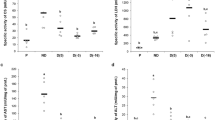Abstract
Prepupae of the Mediterranean arctiid moth Cymbalophora pudica spend hot spring and summer months in a summer diapause (aestivation). Although their cold-hardiness (survival after 1-day exposure to subzero temperatures) is relatively low, it may be moderately enhanced by prior cold acclimation at decreasing above-zero temperatures. In this study, fatty acids of phospholipids and triacylglycerols were analysed in five different tissues (body wall, midgut, fat body, silk glands and brain) dissected from both cold-acclimated and control aestivating prepupae. The five most abundant fatty acids (oleic, palmitic, stearic, linoleic and α-linolenic), found generally in both lipidic fractions and all five tissues, represent a typical fatty complement of Lepidoptera. The fatty acid profiles of individual tissues differed from each other and the response to cold acclimation was also tissue-specific. Moderate but significant increases in the proportion of unsaturated fatty acids after cold acclimation were observed in triacylglycerols of the body wall, fat body and silk glands. Additionally, significant rearrangements of fatty acid profiles were found in triacylglycerols of midgut and brain, without changing the unsaturation/saturation ratio. The adaptational value of enhanced fluidity of fat body triacylglycerols caused by their increased unsaturation remains unclear, because the lipidic energy depots are not utilized during aestivation of this insect. Minimal capacity to alter the membrane-bound fatty acids was found in all tissues except midgut, where the unsaturation/saturation ratio of phospholipids slightly increased after cold acclimation. A low ability to alter the composition of membrane lipids in response to low temperature, correlates well with the low capacity of C. pudica prepupae to enhance their cold-hardiness during cold-acclimation. This may be regarded as indirect support for the membrane lipid restructuring in insect cold adaptation.
Similar content being viewed by others
Author information
Authors and Affiliations
Additional information
Accepted: 11 May 1998
Rights and permissions
About this article
Cite this article
Kostal, V., Simek, P. Changes in fatty acid composition of phospholipids and triacylglycerols after cold-acclimation of an aestivating insect prepupa. J Comp Physiol B 168, 453–460 (1998). https://doi.org/10.1007/s003600050165
Issue Date:
DOI: https://doi.org/10.1007/s003600050165




